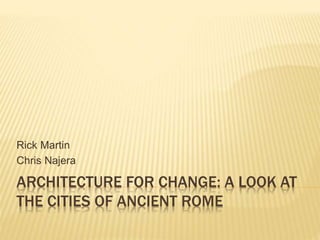
Architecture for change
- 1. ARCHITECTURE FOR CHANGE: A LOOK AT THE CITIES OF ANCIENT ROME Rick Martin Chris Najera
- 2. URBANISM AND ARCHITECTURE (GIURGOLA, 1962) The French word urbanism means "the general study of the conditions, motivations, and life needs and development of the city." The aim of Urbanism as a discipline is the architectural synthesis of all those values which represent the urban aggregate in the broadest sense of the word. Urbanism is an art. It has guided the formation of civic life for centuries.
- 3. CITY ARCHITECTURE: BOTH A CAUSE AND EFFECT OF CHANGE “That the representation of the city is of an artistic order is true today as it never has been. Art has become the simultaneous introduction of all problems, the rational, the practical-functional and the ethical one…Art then is not only generated by the pure and free poetic imagination but merges in the social, technical and historical realities of life” – Giurgola, 1962. “Life imitates Art far more than Art imitates Life” – Wilde, 1889 “In antiquity…science, myth, and building were inseparable” – McGrath and Navin, 1992
- 4. 4 ROMAN ARCHITECTURE Rome was one of the greatest powers of the ancient world, and has also exercised a great influence upon nearly all modern nations. The Roman Empire lasted from 509 BC to AD 330. Early Roman art reflected its past in Etruscan civilization, but as the empire expanded, a distinctly Roman art emerged, the art of many different peoples and classes, from emperors to slaves. The architecture of the Romans was, from first to last, an art of shaping space around ritual. In other words, Ancient Roman architecture was regulated by their custom of a system of rites. Religion/Ritual in ancient was regarded by the Romans as indigenous and central to their identity as a people, as well as the various and many cults imported from other peoples brought under Roman rule. Many of our modern government institutions are modeled after the Roman system, as is much of our public architecture.
- 5. ROMAN ARCHITECTURE: FUNCTIONALISM The Romans were able to sustain large cities because they could provide fresh drinking water and sewage systems. They could move large armies and equipment because they build roadways. They could build large permanent structures to house government, business, as well as residential. Their massive buildings sent a message throughout the known world that this was a powerful culture and people. Many of their structures still stand today and many of their building techniques are still used today.
- 6. ROMAN ARCHITECTURE: FUNCTIONALIST PERSPECTIVE ANCIENT ROME: POPULATION 1,000,000 KEY ELEMENTS TO SUSTAIN POPULATION: FRESH WATER, SEWAGE, FOOD SOURCES, ROADS, HOUSING, GOVERNMENT, AND MILITARY
- 7. UNDERSTOOD THE IMPORTANCE OF ROADWAYS FOR COMMERCE, TRANSPORTATION, TRADE, MILITARY MOVEMENT, AND PUBLIC ACTIVITIES. ROMAN ARCHITECTURE: FUNCTIONALIST PERSPECTIVE
- 8. ROMAN AQUEDUCTS: CARRIED FRESH WATER SEVERAL HUNDRED MILES SUSTAIN THE CITIES AND LAVISH ESTATES. ROMAN ARCHITECTURE: FUNCTIONALIST PERSPECTIVE
- 9. ROMAN ARCHITECTURE: URBANISM “Roman architects and planners created the first coherent western urban system; in doing so, they formulated certain basic truths of architecture…Urban studies highlight other topics effectively—the contextual imperatives of the varied Roman building typology, for example, or the humane provision throughout every municipality of numerous hydraulic and other amenities” – MacDonald, 1988
- 10. ANCIENT ROME FORUM: CENTER FOR RELIGIOUS CELEBRATIONS, LAW, TRADE, PUBLIC MEETINGS, CEREMONIES, GOVERNMENT MEETINGS. ROMAN ARCHITECTURE: URBANISTIC PERSPECTIVE
- 11. ROMAN TEMPLES: ERECTED NOT ONLY IN THE FORUM, BUT THROUGHOUT THE CITY AND IN THE COUNTRYSIDE AS WELL; MANY OTHER TYPES ARE KNOWN. ONE OF THE MOST INFLUENTIAL IN LATER TIMES WAS THE TYPE USED FOR THE PANTHEON (AD 118-28), ROMAN ARCHITECTURE: URBANISTIC PERSPECTIVE
- 12. COLOSSEUM: CENTER FOR PUBLIC ENTERTAINMENT WITH STAGED EVENTS FOR GLADIATOR BATTLES, ANIMALS, HUMANS, ROMAN ARCHITECTURE: URBANISTIC PERSPECTIVE
- 13. ROMAN BATHS: BECAME A DAILY ACTIVITY FOR THE WEALTHY AND THE AVERAGE ROMAN CITIZEN ROMAN ARCHITECTURE: URBANISTIC PERSPECTIVE
- 14. ARCHITECTURE FOR CHANGE The conditions, motivations, functional requirements, and development of the city—the urban environment—are represented by the physical elements of the city. City architecture: both creates and is caused by marco-social change; reflects the paradoxical nature of aesthetics and functionalism in architecture. Built environment reflect the changing cultural and social identities of residents (and society at large)
- 15. MODERN EXAMPLE: GENTRIFICATION Gentrification and urban gentrification denote the socio-cultural changes in an area resulting from wealthier people buying housing property in a less prosperous community. Consequent to gentrification, the average income increases and average family size decreases in the community, which may result in the informal economic eviction of the lower- income residents because of increased rents, house prices, and property taxes.
- 16. QUESTIONS FOR REVIEW What is the relationship between city architecture and the urban environment? How does city architecture simultaneously cause and create macro-social change? Use Roman architecture as an example. How is city architecture used today to create change (from a social conflict theoretical perspective)?